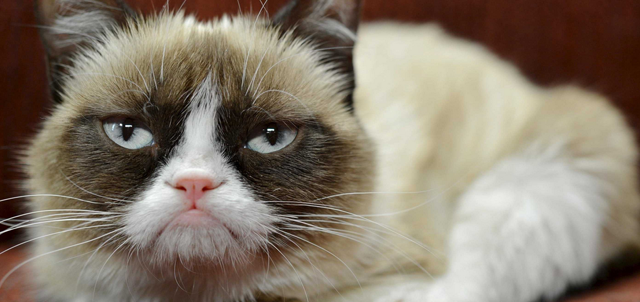Log on for your morning social media updates (whether on Facebook, Twitter, Tumblr, Instagram, Vine or Pinterest), and it won’t be long before you’re greeted with a cute cat meme or dog gif. We have, it seems, an endless fascination with our furry and feathered friends and a constant need to share videos and images of them online. The odds are high that you’ve “liked” some of them, even if you haven’t personally posted any yourself.
It is little surprise, since what happens online is largely an extension of everyday life, and our close relationship with animals goes way back.
And it’s a relationship that has translated seamlessly online to a Web where animals now have the potential to become superstars in their own right, the ever-unimpressed Grumpy Cat being a case in point.
Another critter who has achieved online cult status is the ridiculously cute Pomeranian furball, Boo, who reportedly has more Facebook likes than Will.i.am and features in Likeable’s ranking of the 15 most popular animals that have graced the internet over recent years.
When brands get it right
Perhaps one of the first lessons they teach in social media school is that people love sharing videos featuring cute animals. Personal favourites among the BlogStar team include Cravendale’s #CatswithThumbs campaign…
…and Vileda’s Save Your Cats, a montage of clips depicting what happens when cats get to kitchen spills before their owners. It generated more than 50,000 views in two weeks.
One obvious question that comes to mind is whether these campaigns helped Cravendale or Vileda to sell more milk or mops respectively. The next question would be whether their objective was in fact to boost sales.
Forge a connection
To return to the earlier point, everything we do in the digital world is an extension of our offline lives. As brands, it is crucial to be able to manage this extension of yourself wisely. Brands have played on the close relationship between the human and animal world since the dawn of advertising, with the PG Tips chimpanzees and the Andrex puppies among the most high-profile, best-loved and sustained in a long history of brand associations.
Featuring animals 0n social media posts can create an association to the brand that makes it more recognisable and forges instant emotional connections, but do consider whether doing so aligns with wider brand objectives. What you do on social media will determine how your audience perceives your brand, so whether using cats, dogs, or indeed any other subject matter, some questions to ask include:
1. What is it that your audience would like to see, and why?
2. How would people like to engage with you?
3. How will posting this enhance your online presence?
And to round off, one absolutely crucial question: is there anything cuter than a bulldog puppy that can’t quite manage to roll over yet?

